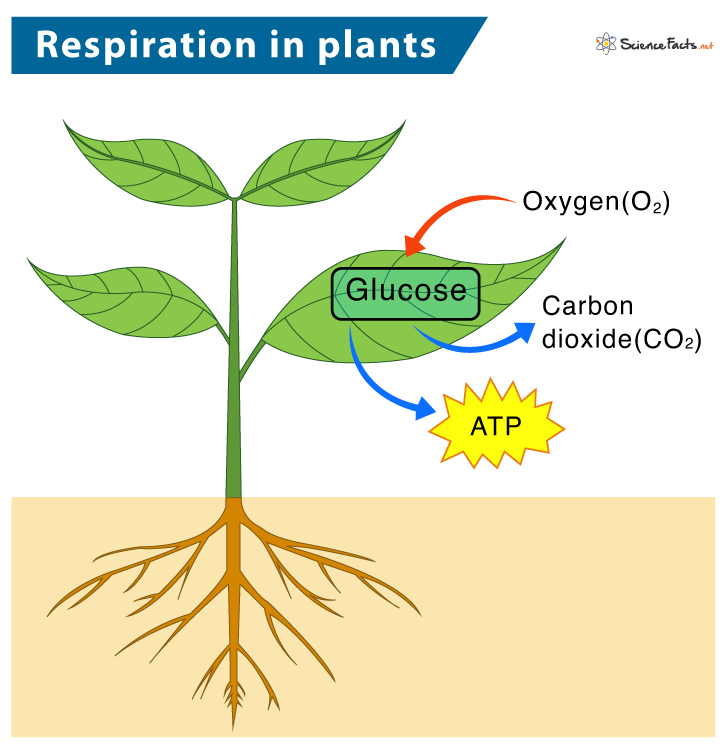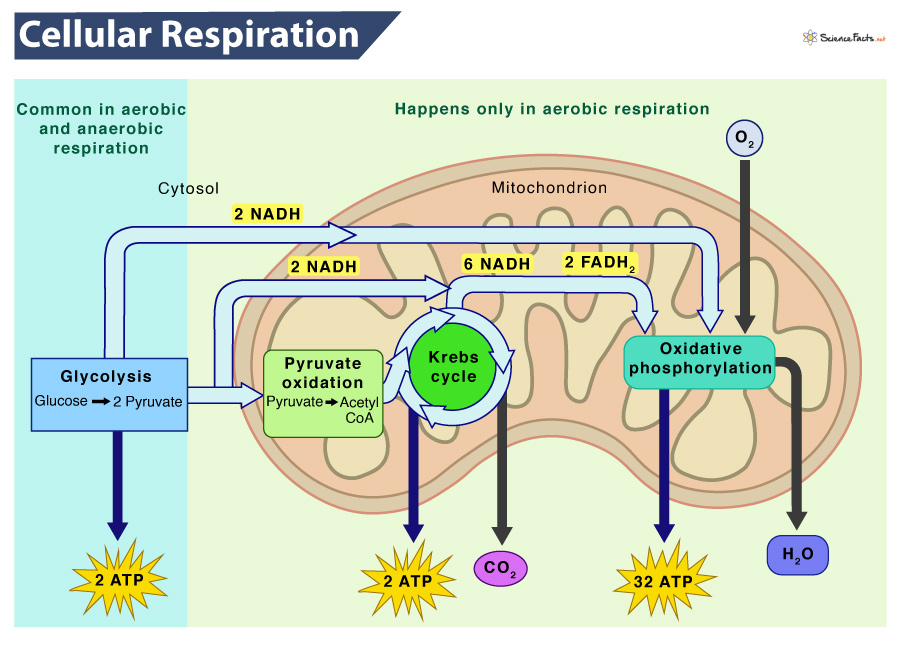Respiration in Plants
Do Plants Breathe
Plants do not perform breathing in its literal sense. Unlike animals, they do not possess any specialized structures like lungs for breathing. Stomata, the minute opening in leaves, and lenticels found in woody stems helps plants in gas exchange. However, similar to other living organisms, respiration occurs in plants throughout their lives to fulfill their energy requirements.
What is Respiration in Plants
Respiration is a set of chemical processes that break down nutrient molecules in living cells to release energy in usable form. In plants, the glucose produced during photosynthesis is broken down in a series of enzyme-facilitated reactions to release energy in the usable form of ATP, producing carbon dioxide and water as byproducts.
The collection of biochemical reactions that plants undergo daily to obtain energy from glucose is called cellular respiration.
When and Where Do Plants Respire
Plants respire throughout day and night, therefore producing carbon dioxide 24 hours. However, during the daytime, a negligible amount of carbon dioxide is released compared to the amount of oxygen produced during photosynthesis. In contrast, at night, respiration is more evident since photosynthesis ceases.
Every part of a plant, such as a root, stem, and leaf, carries out respiration as they do not possess any specialized organ for gaseous exchange.
Respiration in Leaves
Respiration in leaves occurs through stomata, the minute pores present in them. Gaseous exchange of respiratory gases takes place through diffusion via stomata and reaches other cells of the leaves. Carbon dioxide produced during respiration also gets diffused through stomata and moves out of the leaves. The opening and closing of stomatal pores during the exchange of gases are regulated by the guard cells.
Respiration in Roots
The underground parts of the plant, i.e., the roots, also require energy for their survival. They absorb air from the spaces between the soil particles. Root hair, an extension of the epidermal cells of a root, comes in direct contact with the soil. From the air spaces in soil, the oxygen diffuses into the root hair, and from there, it reaches all the other cells of the root where respiration occurs. The gaseous byproduct of respiration, i.e., carbon dioxide, is expelled by the same root hair by diffusion. Thus, respiration in the plant’s roots occurs by the diffusion of oxygen and carbon dioxide through root hairs.
Respiration in Stems
Small herbaceous plants have stomata in their soft stems, allowing the exchange of respiratory gases by diffusion. However, in the case of woody plants, lenticels, a specialized group of loosely packed cells, are present on the stem, which helps exchange O2 and CO2.
Different Types of Plant Respiration
Respiration in plants is categorized mainly into two types based on the presence or absence of oxygen.
Aerobic Respiration: This type of respiration occurs in the presence of oxygen. It involves the complete oxidization of glucose into carbon dioxide and water, releasing energy (36 ATP).
Aerobic respiration is the primary source of energy for plants, occurring in both the cytoplasm and mitochondria. It involves the Krebs cycle, the citric acid cycle, and the electron transport chain. The chemical reaction is given below:
C6H12O6 + 6O2 -> 6CO2 + 6H2O + energy (as ATP)
Anaerobic Respiration:It occurs in the cell cytoplasm in the absence of oxygen. Anaerobic respiration involves partial oxidization of glucose forming ethyl alcohol and carbon dioxide as end products. It involves glycolysis. The chemical reaction is given below:
C6H12O6 -> 2C2H5OH + 2CO2 + Energy
Other Types
In plants, two additional types of respiration take place depending on the presence or absence of light: dark respiration and photorespiration.
Dark respiration is light-independent, i.e., it occurs whether light is present or absent. It is carried out in all aerobic tissues and takes place in the cytoplasm and mitochondria. The three steps of dark respiration are glycolysis, Krebs cycle, and terminal oxidation. In this procedure, carbon dioxide is released at various steps, while oxygen is consumed only in the step of terminal oxidation.
Photorespiration is a metabolic pathway found in photosynthetic cells of higher plants, occurring only in sunlight using energy. It is initiated in chloroplasts and involves the loss of already fixed carbon as CO2. Thus, this is a wasteful process as it does not produce ATP or NADPH.
The Process of Cellular Respiration in Plants
At its initial stage, the glucose molecule is split into two smaller molecules (called pyruvate), liberating a small amount of energy in the form of ATP that transforms glucose. This is an anaerobic process called glycolysis. Next, the pyruvate molecules get rearranged and fuse over again in a cycle. Meanwhile, carbon dioxide is formed, and electrons are removed and placed into an electron transport system. This process yields a lot of ATP for the plant to use for growth and reproduction. As this stage is aerobic, it does need oxygen. The detailed steps of cellular respiration in plants are given below.
Equation
Reactants
- Glucose (C6H12O6)
- Oxygen (O2)
End Products
- Carbon dioxide (CO2)
- Water (H2O)
- Energy (ATP)
Word Equation
Glucose (sugar) + Oxygen = Carbon dioxide + Water + Energy (as ATP)
Chemical Equation
C6H12O6 + 6O2 → 6CO2 + 6H2O + Energy (as ATP)
Steps of Cellular Respiration
Cellular respiration is an oxidative process where glucose gets converted into carbon dioxide, yielding ATP and NADH/FADH2. The process takes place in four stages.
1) Glycolysis: Also known as the Embden-Meyerhof-Parnas pathway, it is the first step of cellular respiration. Glycolysis involves a series of chemical reactions occurring in the cytosol. It first breaks down one molecule (6 carbon sugar) of glucose into glyceraldehyde 3-phosphate (a molecule containing 3 carbons and a phosphate group) using 2 ATP, which in turn produces two molecules of pyruvate (3 carbon molecule). In the end, there is a net gain of 2 molecules of NADH and 2 molecules of ATP.
2) Pyruvate Oxidation: Next, the two pyruvate molecules produced during glycolysis enter the mitochondrial matrix. The pyruvate is converted into a two-carbon acetyl group in an oxidation step (removing a carbon dioxide molecule), later taken up by a carrier compound, coenzyme A (CoA). The product thus formed is called acetyl CoA. Its primary function is to deliver the acetyl group derived from pyruvate to the next step. Eventually, NADH is formed, and carbon dioxide is released.
3) Citric Acid Cycle: The acetyl CoA produced as a result of pyruvate oxidation enters the mitochondrial matrix, the beginning of the Citric Acid Cycle. The acetyl-CoA then combines with the four-carbon molecule oxaloacetate (OAA), resulting in citric acid, a 6 carbon compound, which gives the cycle its significant name. After this, a series of chemical reactions release energy, producing 2 ATP, 8 NADH, 2 FADH2, and 6 CO2 as the end products. This cycle is also known as the Krebs cycle, named after its discoverer Hans Krebs.
4) Oxidative Phosphorylation: It is the final stage of aerobic cellular respiration. Oxidative phosphorylation has two sub-stages, i.e., electron transport chain and chemiosmosis (movement of H+ ions across the semi-permeable membrane). During these stages, the previously formed NADH and FADH2 are used to produce ATP. The NADH and FADH2 deposit their electrons in the electron transport chain. Consequently, energy is released and used to pump out protons from the matrix, raising a gradient. Protons backflow into the matrix with the help of an enzyme called ATP synthase, thus producing ATP. Finally, at the end of the electron transport chain, oxygen accepts electrons and takes up protons to form water.
Among the steps mentioned above, glycolysis is the only one that can take place without oxygen by a process called fermentation. Nevertheless, the other three stages of cellular respiration require oxygen directly or indirectly to continue. For example, only oxidative phosphorylation utilizes oxygen directly, but the rest of the stages are dependent on oxidative phosphorylation to fulfill their oxygen requirement.
When cellular respiration fails to process pyruvate via aerobic respiration due to the absence of oxygen or enzymes, the plant undergoes fermentation. Carbon dioxide and ethanol are produced as a result of the incomplete breakdown of pyruvate during fermentation. This process yields only two molecules of ATP per glucose molecule.
Factors Affecting Respiration in Plants
The eight main factors affecting respiration and its rate in plants are as follows:
- Temperature: Temperature plays a significant role in respiration. The rate of respiration increases with increasing temperatures until it reaches the optimum temperature, after which the enzymes get destroyed. That is why; plants in temperate climates have much lower respiration rates in winter than during warm summers.
- Oxygen Concentration: The rate of respiration increases with increasing oxygen concentration. Under unfavorable conditions, i.e., when there is an inadequate supply of oxygen, plants go through an alternative fermentation process.
- Carbon Dioxide Concentration: As gaseous exchange in plants occurs by diffusion, it is totally under the mercy of the concentration gradient of the respiratory gases. So, if there is a high concentration of carbon dioxide in the environment, it will lower the respiration rate.
- Water Content: Adequate water content in the soil increases the rate of respiration in plants.
- Presence or Absence of Light: Light indirectly affects the rate of respiration. As the light intensity increase, the temperature of the surrounding also rises, thus increasing the rate of respiration. On the other hand, stomata remain open during the daytime, allowing rapid exchange of gases.
- Damage: The rate of respiration increases when any plant cell gets infected or damaged.
- Presence of Salts: The rate of respiration increases in the presence of salts.
- Age of the Cell: The aging of plant tissue negatively affects the rate of respiration in plants. Younger tissues exhibit a higher respiration rate than older ones.
Why Do Plants Need to Respire
Main Purpose
- Obtaining energy by breaking down glucose produced during photosynthesis to carry out all cellular functions.
Other Roles
- Helping in the growth and maintenance of all plant tissues.
- Releasing the trapped solar energy of photosynthesis in a controlled fashion for ATP production (the energy coins).
- Maintaining the carbon balance of individual cells and in nature through the global carbon cycle.
FAQs
Ans. Yes, a plant can photosynthesize and respire at the same time.
Ans. Aquatic plants respire through the stoma present on the upper surface of their leaves.
-
References
Article was last reviewed on Friday, February 3, 2023






The first diagram is just incorrect. Plants absorb CO2 and release oxygen not the way it is in the picture.
The diagram is correct as it shows respiration an not photosynthesis.